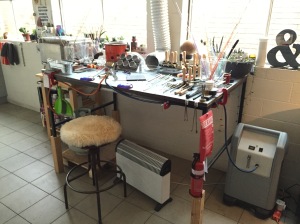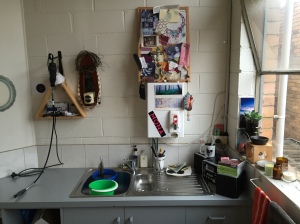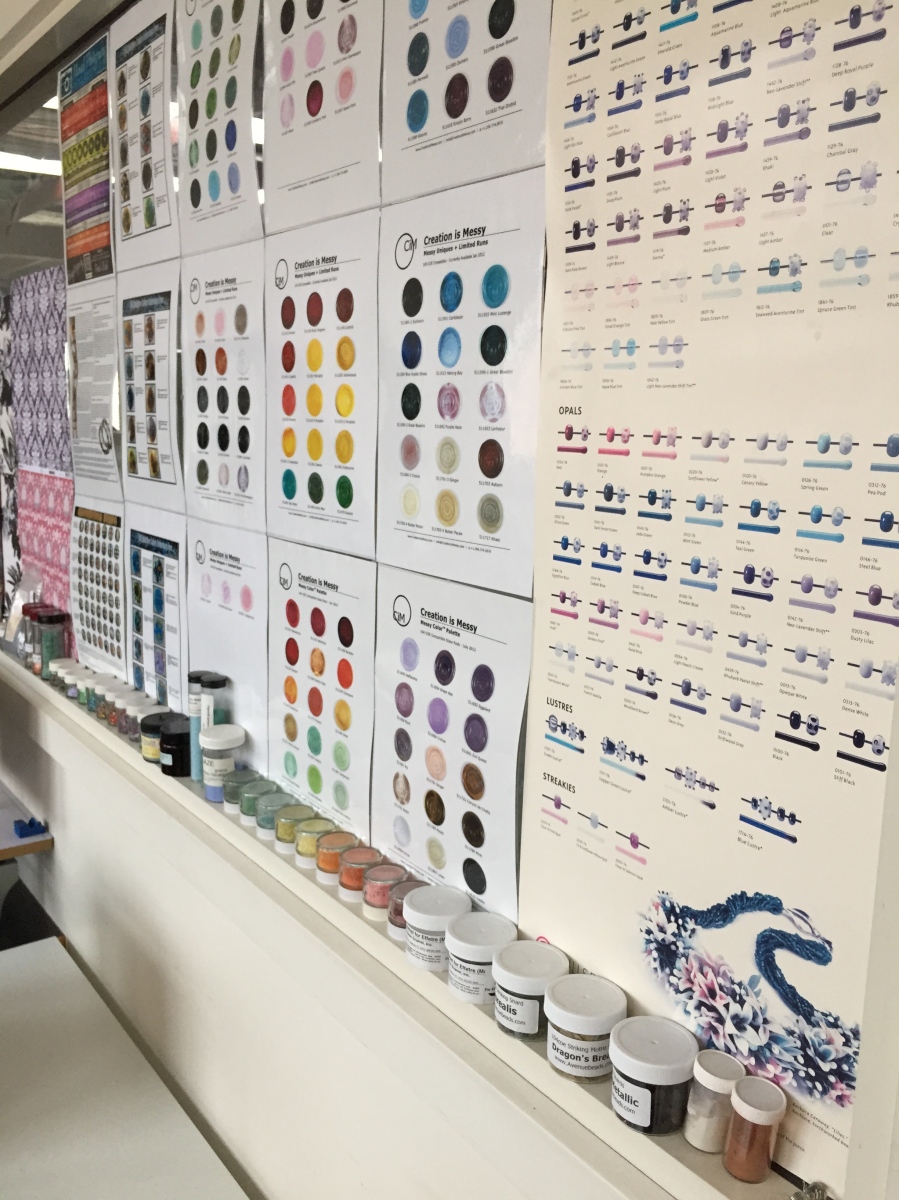
I have set up two bead making studios. My first one was in a spare room in my home. In my excitement and urgency to get underway I made a lot of mistakes with that one. My second studio is in a factory and it took me a long time to find my perfect space. I had a clear idea of what I needed, after learning from the mistakes with my first set up.
A lot of people new to bead making ask very similar questions about how to set up for the first time. There are some great books around that give very helpful advice. I personally found Corina Tettinger’s book; “Passing The Flame” to be the most helpful. Although, being in Australia and so far away from suppliers and manufacturers I had another layer of complication when it came to procuring everything I needed to begin making beads. In these blog posts, I try and address studio set up questions, provide answers to common problems and give my perspective on running a hot glass studio.
What do you want out of making beads?
The first thing you should do (after you have had an introductory lesson and decided that beadmaking is for you) is decide what you want to get out of making beads.
- I want to sell what I make (at shows, galleries, shops, online) as soon as my beads are proficient
- I will not be selling my glass beads (it’s just a hobby)
- I’ll be using my beads in my (suncatchers, jewellery, garlands, etc) and selling finished objects (at shows, galleries, shops, online)
- I may give some beads away as gifts, but not sell, well maybe one or two pieces… if someone asks me…
- I’m not going to start selling right away, but I will eventually
By answering these types of questions you will determine what sort of studio you should be setting up. For instance, there is no point setting up a studio with a kiln if you have no intention of ever selling your beads. By understanding the direction you intend to pursue with your new hobby, you can determine how much money is likely to be involved up front and what your first purchases will be. You can also project how much you will need to save for future purchases.

Choosing your studio space:
I know… I know… everyone wants to buy the torch first. Actually the most important thing is to figure out where the torch will go. When melting glass a lot of fumes are produced and you need adequate ventilation and not to mention space for all the stuff you’re going to accumulate. If you have children, animals or anyone that suffers from asthma living with you, setting up inside your home is not a great idea. Cats need to be kept away for their own good and pinging glass can hit sleeping dogs beneath you (put a bed in a spot away from your desk if you have a pet that likes to be your shadow). If inside your house is your only option for a set up you must install an extraction and ventilation unit for the health of yourself and everyone else in the residence.
Important questions such as;
- Do I have enough space for all the equipment needed for a lampworking studio?
- And is the space suitable for a gas bottle, an oxygen bottle or oxygen concentrator? Need to be answered after familiarising yourself with the equipment needed by a lampworker.
If you’ve answered these questions after looking at the proposed studio and decided it’s not going to be suitable, don’t despair. If you are new to lampworking its not essential to get a really hot torch, perhaps you will be best off with a torch that doesn’t need oxygen, like a Hot Head torch that attaches to the front of a gas bottle. This means your torch is portable and you can potentially make beads wherever you want. If you’re looking around at what spaces are available to you and can’t see an option that fits your budget, you may find that hiring hot glass studio time with another artist is the best solution for right now, until you can afford to create a studio that suits your needs. Don’t force a room to become a studio if the space is unworkable, it will never feel right and you might get injured working in a room that just isn’t meant for hot glass.
How to work out if your space is suitable:
Oxygen and gas bottles located inside your home are not usually covered by home and contents insurance (it’s not in Australia). Working in a factory, shed or garage has advantages as they’re not classed as residences. That means you can have bottled oxygen and gas inside with you, which is easier. If the room you want to torch in is inside your house there are some questions you need to consider;
- Are you prepared to drill through walls?
- Does your home and contents insurance allow you to have gas or oxygen bottles inside or near the external walls of your home?
- You may need to consider buying an oxygen concentrator instead of using bottled oxygen if you live in a region that requires a permit to have oxygen bottles in residential areas.
What if your insurance won’t cover oxygen or gas bottles in or near your home?
- Will you be happy with a single fuel torch like a hot head and using space outside on a porch?
- If you don’t want a single fuel torch, do you have space and the budget for a studio shed in the back yard?
- Can you modify the porch by glassing it in or can you move into the garage, so that you truly have your own space?
Sometimes finding the space is easy and sometimes its not. A lot of lampworkers ignore their house and contents insurance policy by using gas and oxygen bottles inside their home. In my first studio, I found out that my policy allowed only for gas bottles outside on the external walls of the home. I had to drill a hole through the bricks for the pipe. It turned out to be a poor solution, because the pipe was so long (anything over 2.5 metres is going to present issues) that I lost pressure between the bottle and the torch (I couldn’t just turn up the pressure on the bottle, it affected the flame chemistry on the torch). If you have found a space and worked out where you can position gas or oxygen bottles nearby, you may also have to consider the following;
- Are you prepared to remove carpet, floor boards and lay tiles? (pinging glass will burn holes in carpet and wooden floors)
- If you don’t have the option of tiling, are you able to lay down a sheet of metal to protect the floor? (and will your desk and chair be stable on it?)
- Do you have an old rug (that you don’t mind if it gets burned) or can you get a cheap rug from a discount store to cover your floor? Rugs aren’t the best solution as glass can smoulder in them and cause fires.
- If you have concrete, is it sealed properly? (unsealed concrete is dusty)
- Do you have plasterboard or wood panelling that needs covering? (hot glass can fly all over the place when you’re learning)
- Brick or tiled walls are best. If you don’t have that option you can cover plasterboard up with metal sheet.
These are some of the reasons why so many artists work in a shed or garage. The practicality of the situation means that their home is not breached by massive modifications and the freedom to be an artist (and make a mess) is afforded to you by having a space you’re not stressing about keeping clean or burn free.
By far the most important consideration is how you will install proper ventilation into that room. You can’t get away with only an open door or window as a source of ventilation. You do need a door or window open for a supply of fresh air, but you also need an actual extraction unit or ventilation fan as well (I cover this in a blog on ventilation systems). Glass is coloured with metals and oxides. When you melt glass these oxides and metals burn off and disperse into the immediate atmosphere. These particles will settle on any surface (and down your lungs) if not sucked up and dispelled outside and away from your source of fresh air. Over time, the particles will inflict serious health risks to your lungs. Look at your space, get up into the roof if you have to and see where the beams are and how much space is available to you outside of your studio (a potential place to rest a ventilation unit). Then work with a qualified electrician to select a ventilation unit that is suitable. Some things to ask yourself are:
- Will you be able to sit an extractor unit in the roof cavity? (mine is in the roof cavity with a pipe leading down directly in front of my torch)
- If not, can you attach an extraction hood (like a kitchen canopy exhaust fan or “rangehood”) to your wall above your workstation?
- Will you be able to place the unit right above or in front of the torch, which is where it needs to be?

A hot glass studio requires electricity.
Do you have power to that room and enough power points? I found that I needed a lot more than just one double socket. Running an extension cord from your house and using a powerboard seems like an easy solution, but it comes at a price. You would need to know that if your kiln, heater/cooler, radio, oxygen concentrator, etc are all running off that one extension cord that it wouldn’t overload your circuit breakers. If that is all okay, make sure it won’t overload if someone decided to run the microwave/toaster/washing machine etc inside your home at the same time. If you’re determined to go with that option then, the extension cord would have to be thread through a piece of agi pipe and buried under the garden to ensure it didn’t get damaged by the elements if you forgot it outside one day. Then again, someone clumsy might trip on it and unplug your entire studio even with that precaution. If you can’t afford an electrician, the good old extension cord to the garage trick is a very short term solution, that I don’t recommend.
- Another thing to consider is that cleaning beads makes a bit of mess. Do you have a sink nearby or do you want a sink in your studio? I used to make a mess of my kitchen trying to clean beads, and it was annoying for anyone else trying to use the kitchen. However, the kitchen in my first house was tiny and the laundry had no bench. If you have a lovely big kitchen or laundry, you don’t need to worry about having a sink in your studio.
- Natural lighting is important in beadmaking. Glass colour can change under different types of lighting. LED and Fluorescent/Incandescent lights are known colour changers. This is a fun aspect of glass for your buyers to enjoy, but its not something you want to get mixed up about when making glass beads. Changing globes to a more natural light is not hard to do, but if the overhead lights are behind you and your going to cast shadows over your workspace, another hidden cost is buying lamps or having an electrician install a light over your workspace.
- Is the room dim or bright, will you be able to see the flame?
- Is the room drafty, potentially blowing your flame around?
- Does it have a lack of air movement or have no window for fresh air?
- Does it get extremely cold or always warm?
- These small things effect your torch and ventilation placement, which may change how you intend to lay out the room.
- Some of these things may bear hidden costs that you might not have budgeted for initially.
- It may also come down to the fact that your ventilation can only be in a certain place because the electrician cannot install it anywhere else due to space restrictions and your workable room has suddenly become less workable.
Ambient Temperature Changes in your Studio
If you come from a very hot climate, you will need to assess how hot the room gets just from natural sunlight. A dual fuel torch in a small room will increase the ambient temperature by up to 4 degrees celcius. So be prepared for that. If you live in a very cold climate, certain limitations will need to be considered, for instance, you may not be able to put your extraction fan outside because of freezing temperatures icing up the filters. You may need to build an insulator box and keep the entire extraction unit inside, with a vent leading out through a wall or window.
What if you have no space anywhere that is suitable?
- Sometimes you just need to get on with it and make it happen for the ball to get rolling:
- Set up a trolley with your equipment and get torching in a ventilated space like the verandah, porch, garage, shed, in the garden under the trees using the most portable single fuel torch you can find. Just practice! If the passion for bead making has really hit you or you decide its time to get more serious about lampworking, then you might want to consider renting space and setting up a studio. Or getting a loan to convert a room/garage or buy a shed for the backyard to create a studio.
- If lampworking is the thing for you to do on a more permanent basis and you have the finances to improve your surroundings and create a studio, go for it. Set goals and work towards getting that space, that torch, that kiln and that oxygen concentrator, along with glass, lots and lots of beautiful glass.
- If you are already lampworking and know its the hobby for you:
- Seriously consider the space you want to set up in. Don’t be afraid to modify it/build it if necessary to suit your needs if lampworking has become your passion.
- Go for the quality installments that you can afford now, then save up for the rest.
- Set your goals accordingly and reasonably. I’m assuming you already have your torch and a small space that you’re looking to improve. If you’re looking to upgrade your torch that is secondary to a quality extraction unit, then oxygen concentrator/s, then the kiln of your dreams (in that order).
- Remember, you can batch anneal your beads or send your beads away to be annealed, so a kiln isn’t as necessary as it appears whilst your starting out.
- If your room needs modifying that takes precedence before anything else, particularly if you cannot get ventilation in. You cannot torch without an extraction fan and you don’t need an oxygen concentrator right away or a kiln. What you do need is , the right space, ventilation and then, the fancy tools.
See, I told you buying a torch wasn’t the most important thing to do first!


Hi, Sadly I need to sell the contents of my lampwork glass studio. Could you give me any suggestions as to where I might be able to list my many items for sale. Thanks so much for your time.
LikeLike
Hi Karen, You can ask in this group https://www.facebook.com/groups/lampworkbeadmaking/ for a good place to sell your equipment depending on what country and state you’re in. 🙂
LikeLike